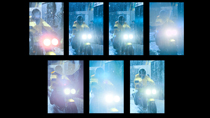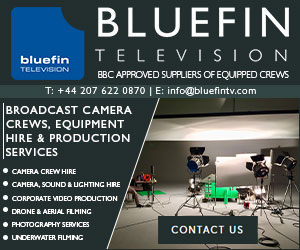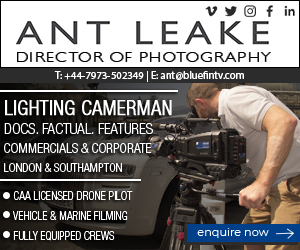Broadcast News
04/10/2012
Collaborative Projects Give IBC Layers Of Added Value

Rich streams of knowledge: George Jarrett looks back at IBC, during which standard setting bodies generated much of the big news. He picks on a Quantel app as the cleverest tool he saw, and selects MPEG-DASH as champion example of how commercial entities can work together for the greater good of the market.
IBC was a wonderfully sophisticated event, thanks in large part to the high quality of those attending, and the efforts made on behalf of the market by the strongly backed collaborative groups who work to give us standards, and keep proprietary wolves from the door.
Genuine brand new products were difficult to locate amongst many hundreds of improved, replacement and new application technologies, but thanks to developments like MPEG-DASH, FIMS, DVB-S2 and DVB-T2 Lite, the DPP workflow app for producers, and the ICAS camera tests and associated ACES workflow, visitors had rich streams of knowledge to tap.
The EBU staged several fascinating demonstrations. One showed 4K at 50p with HEVC video encoding in exactly the same bit rates as used for HDTV today, and increased bit rates to eradicate artifacts, and highlighted the fact that 4K in the movies is 4096 x 2160, whilst 4K for TV is 3840x2160. The best EBU component however highlighted the 40-member DASH industry Forum’s promotion of the (unifying) streaming protocol MPEG-DASH.
Backed enthusiastically by the likes of Samsung, Microsoft, Dolby, Ericsson and Harmonic, this gives the user adaptive streaming over HTTP with the automatic variance of bit rates according to available bandwidth. The market wanted a single file format for delivering to all devices, and one that works with HbbTV. It now has it, but Apple and a few Android adopters have to come on line.
The Framework for Interoperable Media Services (FIMS) – jointly developed by the EBU and the Advanced Media Workflow Association (AMWA) and promoted by an impressively powerful FIMS business board – has been passed to SMPTE for accelerated standardisation. What was talked about as the framework for FIMS 2.0 – quality assurance, repositories, cloud management, and multi system orchestration – has been heavily influenced by adopters and supporters like Bloomberg, BBC, CBC, HBO, ITV, MTV, NBC, RAI, Turner, Viacom, and Red Bee. Vendor wise, Dalet was the latest to offer a FIMS implementation.
FIMS has become mighty important to the evolution of workflows, and another key collaborative grouping the Digital Production Partnership (DPP) has made its own very interesting contribution with a metadata App. This will enable non technical production company staff to create standardised technical and editorial metadata for supporting the DPP’s new AS-11 file delivery format.
As close as can be to an idiot’s guide to entering sensible metadata, the App embeds metadata into MXF program files. It should have a short life, because it is a function that belongs in vendor systems. As it stands, it will reduce confusion and cut some costs, and the adoption of the full DPP metadata logic by ITV’s long-running soap Emmerdale is a big step forward, as is Channel 4’s decision to take delivery of completed programs via AS-11 on a selected basis as of IBC.
The DVB has given us all of our transmission formats, and for IBC it had DVB– S2 and -T2 Lite to excite broadcasters.
S2 (an ‘annex’) allows for the accommodation of wideband transponders, and gives broadcasters enormous bandwidths up to 500 MHz. To give a comparison, they have lived with 30-50 MHz.
The excitement here is that S2 points at the delivery of Ultra HDTV (4K) and full quality 3D services in the future, but going any deeper requires an understanding of time-sliced transmission.
The DVB technical module has now approved the technical specification for Next Generation Handheld (NGH, and twinned to this is the delivery technology T2-Lite, now a 7mm chip after appearing at IBC 2011 as a set of huge boxes from BBC R&D. Like the development of FIMS the T2-Lite chip shows just how fast collaborative groups can work now. Will the commercial companies adopt it? Just watch Sony, Panasonic and Samsung.
The coming together of the American Society of Cinematographers (ASC), Producers Guild of America (PGA) and the Academy of Motion Picture Arts and Sciences for the Image Control Assessment Series (ICAS) camera tests, created one of the key conference sessions at IBC, and this highlighted the impact of the Academy Color Encoding System (ACES) on workflows along with impressive performances from most of the cameras involved.
Attendees reckoned that 50% of European post houses know what ACES is, and that 50% do not know yet. The intention is that users will be able to return to their masters and re-format for technologies we have yet to see introduced. Meanwhile, this collaborative group has already started working on its next set of camera assessments, to cover stereoscopic 3D and higher frame rates. Look out for the soon to be published SMPTE report on higher frame rates, in the context of movies.
The elephants in the halls were higher frame rates, and the possible merging of 4K and 3D before IBC next year. Stereoscopic 3D during IBC was painted in two different ways – for movies a new production language for creating better stories is urgently required, while the big requisite for 3D in broadcasting is scripted comedy and drama. The answers to both needs may be about to happen because The Hobbit, Stalingrad and The Great Gatsby are about to hit cinemas screens, and two American episodic shows have gone into production with 3D rigs provided by 3ality.
Holly grail as a term has been over used for 3D ambitions, but where it does stick is the desire for glasses-free 3D (auto stereo). The accepted facts seem to be that there are still prime viewing angle problems and that the best viewing medium, a 4K screen, is too pricey for the consumer market as yet.
Another sub plot of IBC was the suggestion (from NHK) that going for 4K might amount to ‘short terminism’, but we are unlikely to see an 8K-program service anywhere but Japan before 2020.
The consumer potential of 4K, and the longer distance potential of 8K has become a hot subject in the DVB commercial module. Other DVB news concerns its set of 3D standards.
It started with frame compatible 3D, moved to service compatible 3D, and then to a service compatible system boosted by Multi-View Coding (MVC). Expect another technology which improves the resolution available with frame compatible services: this will be a top up signal, but due to compression issues may not be available for two years.
The suggestion that IBC is becoming an App show was franked by some clever pixel magic from Quantel called SynthIA. Introduced as an ultra-high quality Interaxial Synthesis tool, this will end up embedded in the Pablo Rio. It might also be a stand-alone app, and might be a plug-in.
The difficult bit is working out what the cameras would have seen had they been in different positions. This means conjuring up pixels at a very high quality level, and during the show Quantel was processing at about one frame per second – hardly a live application for 3D sports say. But for feature films and the huge 2D to 3D conversion market it is the tool everyone has been waiting for.
SynthIA uses very bit of information it can, measuring disparity, and looking at the images before and after the one you are working on. It then builds depth maps, and will synthesize the new pixels as if from what you would have seen from the camera originally.
IBC was a wonderfully sophisticated event, thanks in large part to the high quality of those attending, and the efforts made on behalf of the market by the strongly backed collaborative groups who work to give us standards, and keep proprietary wolves from the door.
Genuine brand new products were difficult to locate amongst many hundreds of improved, replacement and new application technologies, but thanks to developments like MPEG-DASH, FIMS, DVB-S2 and DVB-T2 Lite, the DPP workflow app for producers, and the ICAS camera tests and associated ACES workflow, visitors had rich streams of knowledge to tap.
The EBU staged several fascinating demonstrations. One showed 4K at 50p with HEVC video encoding in exactly the same bit rates as used for HDTV today, and increased bit rates to eradicate artifacts, and highlighted the fact that 4K in the movies is 4096 x 2160, whilst 4K for TV is 3840x2160. The best EBU component however highlighted the 40-member DASH industry Forum’s promotion of the (unifying) streaming protocol MPEG-DASH.
Backed enthusiastically by the likes of Samsung, Microsoft, Dolby, Ericsson and Harmonic, this gives the user adaptive streaming over HTTP with the automatic variance of bit rates according to available bandwidth. The market wanted a single file format for delivering to all devices, and one that works with HbbTV. It now has it, but Apple and a few Android adopters have to come on line.
The Framework for Interoperable Media Services (FIMS) – jointly developed by the EBU and the Advanced Media Workflow Association (AMWA) and promoted by an impressively powerful FIMS business board – has been passed to SMPTE for accelerated standardisation. What was talked about as the framework for FIMS 2.0 – quality assurance, repositories, cloud management, and multi system orchestration – has been heavily influenced by adopters and supporters like Bloomberg, BBC, CBC, HBO, ITV, MTV, NBC, RAI, Turner, Viacom, and Red Bee. Vendor wise, Dalet was the latest to offer a FIMS implementation.
FIMS has become mighty important to the evolution of workflows, and another key collaborative grouping the Digital Production Partnership (DPP) has made its own very interesting contribution with a metadata App. This will enable non technical production company staff to create standardised technical and editorial metadata for supporting the DPP’s new AS-11 file delivery format.
As close as can be to an idiot’s guide to entering sensible metadata, the App embeds metadata into MXF program files. It should have a short life, because it is a function that belongs in vendor systems. As it stands, it will reduce confusion and cut some costs, and the adoption of the full DPP metadata logic by ITV’s long-running soap Emmerdale is a big step forward, as is Channel 4’s decision to take delivery of completed programs via AS-11 on a selected basis as of IBC.
The DVB has given us all of our transmission formats, and for IBC it had DVB– S2 and -T2 Lite to excite broadcasters.
S2 (an ‘annex’) allows for the accommodation of wideband transponders, and gives broadcasters enormous bandwidths up to 500 MHz. To give a comparison, they have lived with 30-50 MHz.
The excitement here is that S2 points at the delivery of Ultra HDTV (4K) and full quality 3D services in the future, but going any deeper requires an understanding of time-sliced transmission.
The DVB technical module has now approved the technical specification for Next Generation Handheld (NGH, and twinned to this is the delivery technology T2-Lite, now a 7mm chip after appearing at IBC 2011 as a set of huge boxes from BBC R&D. Like the development of FIMS the T2-Lite chip shows just how fast collaborative groups can work now. Will the commercial companies adopt it? Just watch Sony, Panasonic and Samsung.
The coming together of the American Society of Cinematographers (ASC), Producers Guild of America (PGA) and the Academy of Motion Picture Arts and Sciences for the Image Control Assessment Series (ICAS) camera tests, created one of the key conference sessions at IBC, and this highlighted the impact of the Academy Color Encoding System (ACES) on workflows along with impressive performances from most of the cameras involved.
Attendees reckoned that 50% of European post houses know what ACES is, and that 50% do not know yet. The intention is that users will be able to return to their masters and re-format for technologies we have yet to see introduced. Meanwhile, this collaborative group has already started working on its next set of camera assessments, to cover stereoscopic 3D and higher frame rates. Look out for the soon to be published SMPTE report on higher frame rates, in the context of movies.
The elephants in the halls were higher frame rates, and the possible merging of 4K and 3D before IBC next year. Stereoscopic 3D during IBC was painted in two different ways – for movies a new production language for creating better stories is urgently required, while the big requisite for 3D in broadcasting is scripted comedy and drama. The answers to both needs may be about to happen because The Hobbit, Stalingrad and The Great Gatsby are about to hit cinemas screens, and two American episodic shows have gone into production with 3D rigs provided by 3ality.
Holly grail as a term has been over used for 3D ambitions, but where it does stick is the desire for glasses-free 3D (auto stereo). The accepted facts seem to be that there are still prime viewing angle problems and that the best viewing medium, a 4K screen, is too pricey for the consumer market as yet.
Another sub plot of IBC was the suggestion (from NHK) that going for 4K might amount to ‘short terminism’, but we are unlikely to see an 8K-program service anywhere but Japan before 2020.
The consumer potential of 4K, and the longer distance potential of 8K has become a hot subject in the DVB commercial module. Other DVB news concerns its set of 3D standards.
It started with frame compatible 3D, moved to service compatible 3D, and then to a service compatible system boosted by Multi-View Coding (MVC). Expect another technology which improves the resolution available with frame compatible services: this will be a top up signal, but due to compression issues may not be available for two years.
The suggestion that IBC is becoming an App show was franked by some clever pixel magic from Quantel called SynthIA. Introduced as an ultra-high quality Interaxial Synthesis tool, this will end up embedded in the Pablo Rio. It might also be a stand-alone app, and might be a plug-in.
The difficult bit is working out what the cameras would have seen had they been in different positions. This means conjuring up pixels at a very high quality level, and during the show Quantel was processing at about one frame per second – hardly a live application for 3D sports say. But for feature films and the huge 2D to 3D conversion market it is the tool everyone has been waiting for.
SynthIA uses very bit of information it can, measuring disparity, and looking at the images before and after the one you are working on. It then builds depth maps, and will synthesize the new pixels as if from what you would have seen from the camera originally.
Top Related Stories
Click here for the latest broadcast news stories.
12/02/2024
Leader's Advanced 4K Test And Measurement To Be Showcased at BSC Expo 2024
Leader Electronics Europe has announced that enhancements to its state-of-the-art 4K test and measurement technology will be previewed at BSC Expo 202
Leader's Advanced 4K Test And Measurement To Be Showcased at BSC Expo 2024
Leader Electronics Europe has announced that enhancements to its state-of-the-art 4K test and measurement technology will be previewed at BSC Expo 202
12/01/2024
AJA Releases Dante AV 4K v1.1
AJA Video Systems has released Dante AV 4K v1.1, the first update for its Dante AV 4K-T and 4K-R transmitter/receiver converters, which enable the tra
AJA Releases Dante AV 4K v1.1
AJA Video Systems has released Dante AV 4K v1.1, the first update for its Dante AV 4K-T and 4K-R transmitter/receiver converters, which enable the tra
18/02/2011
On Sight Uses SGO's Mistika For Flying Monsters In 3D With David Attenborough
SGO Mistika, the most powerful stereoscopic 3D toolset in the industry, was used for all the stereo 3D , 2D; and its first evert 3D IMAX by London's O
On Sight Uses SGO's Mistika For Flying Monsters In 3D With David Attenborough
SGO Mistika, the most powerful stereoscopic 3D toolset in the industry, was used for all the stereo 3D , 2D; and its first evert 3D IMAX by London's O
17/09/2010
SENSIO 3D Recognised At IBC
SENSIO Technologies has announced a successful IBC show in Amsterdam, where 3D broadcasting was high on the organisers' and visitors' agenda. The IBC
SENSIO 3D Recognised At IBC
SENSIO Technologies has announced a successful IBC show in Amsterdam, where 3D broadcasting was high on the organisers' and visitors' agenda. The IBC
13/12/2023
Ikegami Experiences Continuing Advance To 4K-Native Broadcast Production
Ikegami rhas reported a sustained advance towards 2160p 4K-UHD as the globally preferred mastering format among television production companies creati
Ikegami Experiences Continuing Advance To 4K-Native Broadcast Production
Ikegami rhas reported a sustained advance towards 2160p 4K-UHD as the globally preferred mastering format among television production companies creati
20/11/2023
Videosys To Display Epsilon 4K Base Station CCU
Videosys Broadcast will be showcasing its Epsilon 4K base station Camera Control Unit (CCU) to German audiences as part of a five-city tour organised
Videosys To Display Epsilon 4K Base Station CCU
Videosys Broadcast will be showcasing its Epsilon 4K base station Camera Control Unit (CCU) to German audiences as part of a five-city tour organised
10/11/2023
Sonnet Unveils USB-C® To Dual 4K 60Hz HDMI® Adapter
Sonnet Technologies has announced the USB-C® to Dual 4K 60Hz HDMI® Adapter, a new addition to the company's line of dual-display adapters for Apple® M
Sonnet Unveils USB-C® To Dual 4K 60Hz HDMI® Adapter
Sonnet Technologies has announced the USB-C® to Dual 4K 60Hz HDMI® Adapter, a new addition to the company's line of dual-display adapters for Apple® M
18/01/2008
U2 3D To Premiere In Dolby 3D At Sundance Film Festival
Dolby Laboratories, Inc. has announced that the world premiere of 3ality Digital Entertainment’s U2 3D, distributed by National Geographic Entertainme
U2 3D To Premiere In Dolby 3D At Sundance Film Festival
Dolby Laboratories, Inc. has announced that the world premiere of 3ality Digital Entertainment’s U2 3D, distributed by National Geographic Entertainme
10/08/2011
A/V Giants Join Forces In 'Full HD 3D Glasses Initiative'
Four audio/video giants have announced their intent to collaborate on the development of a new technology standard for consumer 3D active glasses, und
A/V Giants Join Forces In 'Full HD 3D Glasses Initiative'
Four audio/video giants have announced their intent to collaborate on the development of a new technology standard for consumer 3D active glasses, und
07/12/2010
PLF Announces Three-Day 3D Training Course
Principal Large Format (PLF) has announced that it will lead a three-day training course on 3D cinema and television next January in London. Titled Ad
PLF Announces Three-Day 3D Training Course
Principal Large Format (PLF) has announced that it will lead a three-day training course on 3D cinema and television next January in London. Titled Ad
02/07/2012
Sky And Sony Capture Goodwood Festival Of Speed In 3D For The First Time
Sky and Sony have revealed that they filmed and screened the iconic Goodwood Festival of Speed in High Definition 3D for the first time ever over the
Sky And Sony Capture Goodwood Festival Of Speed In 3D For The First Time
Sky and Sony have revealed that they filmed and screened the iconic Goodwood Festival of Speed in High Definition 3D for the first time ever over the
07/12/2011
3D Entertainment Industry Looking Positive
Endless reports about the downturn of 3D cinema have emerged with claims from mainstream media that 3D cinema is over but the last few months have saw
3D Entertainment Industry Looking Positive
Endless reports about the downturn of 3D cinema have emerged with claims from mainstream media that 3D cinema is over but the last few months have saw
12/03/2009
Sony And Reald To Provide Complete 3D Digital Cinema System For Exhibitors
Sony And Reald To Provide Complete 3D Digital Cinema System For Exhibitors Sony Electronics and RealD are working together to provide exhibitors with
Sony And Reald To Provide Complete 3D Digital Cinema System For Exhibitors
Sony And Reald To Provide Complete 3D Digital Cinema System For Exhibitors Sony Electronics and RealD are working together to provide exhibitors with
06/03/2023
TNDV Invests In Sony 4K/HD Cameras
TNDV has made its second large capital investment in Sony 4K/HD cameras to support increased demand for Sony-driven 4K workflows. With its recent purc
TNDV Invests In Sony 4K/HD Cameras
TNDV has made its second large capital investment in Sony 4K/HD cameras to support increased demand for Sony-driven 4K workflows. With its recent purc
03/12/2009
3D Camera Rigs Marketed By Offhollywood
A digital cinema company, Offhollywood, will be the first east coast US company to market with the latest Technica 3D camera rigs. These will offer ad
3D Camera Rigs Marketed By Offhollywood
A digital cinema company, Offhollywood, will be the first east coast US company to market with the latest Technica 3D camera rigs. These will offer ad














